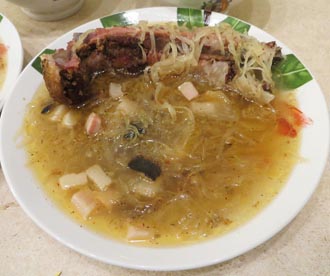Table of Contents
Buying
Traditionally, sauerkraut is made with cabbage, salt, and water. Some commercial varieties may also include spices or other vegetables.
Sauerkraut can vary in taste and texture, ranging from mild to tangy and from crunchy to softer. Consider your personal preference and experiment with different brands and varieties to find the one you enjoy the most.
Fresh sauerkraut will have a vibrant color and crisp texture. Avoid sauerkraut that looks discolored, mushy, or has a foul smell, as these are signs of spoilage. Also, avoid that has additives, preservatives, or excessive amounts of salt.
Storing
Sauerkraut is a fermented food that demands proper storage is essential to maintain its flavor and quality. It is preferable to store sauerkraut in glass jars or containers. Transfer the sauerkraut to an airtight container or jar and make sure it is fully submerged in its liquid (brine). This will help preserve its freshness and prevent it from drying out. Store it in the refrigerator at a temperature below 40°F (4°C).
It’s a good practice to label the container with the date of preparation. This allows you to keep track of its freshness and ensures you use it within a reasonable time frame.
When stored properly in the refrigerator, sauerkraut can last for several months, maintaining its flavor and quality. However, over time, it may continue to ferment and develop a stronger sour taste.
Remember to use clean utensils and avoid cross-contamination when removing sauerkraut from the container to prevent spoilage. If you notice any signs of mold, off odors, or sliminess, discard the sauerkraut as it may indicate spoilage.
Food uses
Sauerkraut has a tangy and sour flavor and is often used as a condiment or ingredient in various dishes.
 |
| Sauerkraut soup (Kapuśniak). Courtesy: Varchar N |
-
Sauerkraut has a tangy and sour flavor and is often used as a condiment or ingredient in various dishes. Here are some popular uses of sauerkraut in food:
-
Sandwiches and Wraps: Sauerkraut adds a tangy and crunchy element to sandwiches and wraps. It is commonly used in Reuben sandwiches, which typically include corned beef, Swiss cheese, Russian dressing, and sauerkraut on rye bread.
-
Sausages and Hot Dogs: Sauerkraut is a classic topping for sausages and hot dogs. It provides a tart and zesty contrast to the savory flavors of the meat.
-
Stews and Casseroles: Sauerkraut can be added to stews and casseroles to impart a unique flavor. It works well with ingredients like potatoes, carrotse, and meats such as pork or sausage.
-
Soups: Sauerkraut can be used as an ingredient in soups, particularly in Eastern European cuisine. It adds a sour and tangy note to the soup base and complements the other ingredients.
-
Salads: Sauerkraut can be incorporated into salads for added texture and flavor. It pairs well with ingredients like apples, bacon, and cheese.
-
Pierogies and Dumplings: Sauerkraut can be used as a filling for pierogies (Eastern European dumplings) or added to dumpling fillings. It provides a delicious contrast to the dough and other ingredients.
-
Side Dish: Sauerkraut can be served as a side dish alongside meats, such as roast pork or sausages. It can be warmed up or served cold, depending on personal preference.
-
Sauces and Dressings: Sauerkraut can be blended or pureed and used as a base for sauces or dressings. It adds a unique tanginess to the flavor profile.
Safety profile
Sauerkraut has been consumed for centuries and is generally considered safe for most people when consumed in moderation.
Foodborne Illness: Like any fermented food, sauerkraut can be susceptible to contamination if not prepared, stored, or handled properly.
Sodium Content: Sauerkraut is often salted during the fermentation process. As a result, sauerkraut can be relatively high in sodium. Individuals on a low-sodium diet or with specific health conditions, such as hypertension, should be mindful of their sauerkraut intake.
Gas and Digestive Issues: Some individuals may experience gas, bloating, or other digestive discomfort when consuming sauerkraut, particularly if they have a sensitive digestive system or underlying digestive conditions.
Interaction with Medications: Certain medications, such as blood thinners or immunosuppressants, may interact with fermented foods due to their high vitamin K content or potential for microbial activity.
(Medical Disclaimer: The information and reference guides on this website are intended solely for the general information of the reader. It is not to be used to diagnose health problems or for treatment purposes. It is not a substitute for medical care provided by a licensed and qualified health professional. Please consult your health care provider for any advice on medications.)
≺≺-Back to Cabbage from Sauerkraut.
≺≺-Back to Home page.
Further Resources:
-
Understanding and making Sauerkraut. (pdf, opens in new window).
-
USDA National Nutrient data base (opens in new window).
-
Health benefits of sauerkraut –BBC good food. (opens in new window).




More Stories
The One Thing You Should Never, Ever Do if You Have Insulin Resistance and Want to Lose Weight
Tuna Salad Lunch Box – JSHealth
Advanced Wellness Course – Heart Health